Posting Rollup - 2008
2479 Update - December 2008
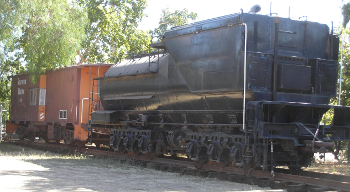
The last journal wedge was installed mid November. It seems that we forgot to trim the wedge to its required thickness before installation. With boiler finally sitting on its wheels, the steel beam that supported the firebox end of the locomotive was removed. All cribbing and jacks were removed and stored.
Our focus has now been turned towards relocating to the area designated by the county. Significant progress had been made during the past several months towards complying with the county's requests. Earlier all rail material and round house building materials were moved. The locomotive's tender and caboose were repositioned, but much work remains before we are fully in the new area.
Fairgrounds staff have been most helpful. Construction of a 36 foot by 28 foot concrete pad has been completed. This will become our outdoor covered work/machine area. The immediate area around the pad has been dressed with base rock and leveled. 350 feet of conduit has been laid for electrical power to the shop area. 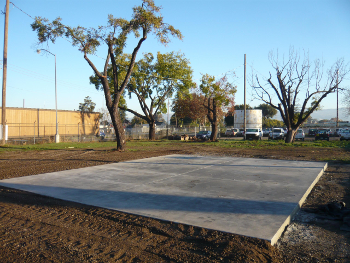
The past three weekends have been spent repositioning the two 36 foot containers that serve as our indoor machine shop and finished parts storage. Both units are now sitting adjacent to the new pad. Moving these objects have consumed all of our time. The shop container requiring the most, as it contained two very heavy lathes and Bridgeport mill. 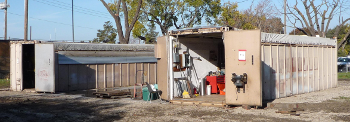
A special event occurred on December 10th. NBC channel 11 visited the site and performed a live broadcast on CTRC's restoration of SP2479. Ken Middlebrook was interviewed by Bob Redell for the 11:00 news.
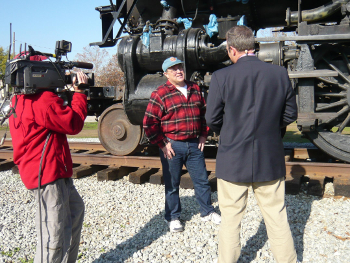
Not all the news has been good. On December 6th while moving the first container, our large Clark forklift suffered a major casualty. A shaft between the drive line and the transmission broke. The repair is not difficult, but the part is not readily available. Efforts to locate the part are on-going. If a part can not be located, one of our journeymen machinists will be called upon to make one.
Fortunately A Tool Shed has again come to our aid by providing a forklift. Thank you again A Tool Shed.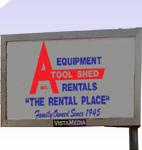
2479 Update - Nov 8, 2008
Today's major task was the installation of the three remaining wedges and pedestals binders. This task consumed most of the day.
An issue remains with the right wedge for number three driver. It was decided that pulling the locomotive back a small distance might help correct the problem. For the first time since December 1990, the locomotive rolled easily upon its own wheels (with a forklift providing power).
While the group struggled with wedges and binders other members continued to relocate materials to the new area. No additional material can be relocated until new site preparations are complete.
2479 Status - Nov 1, 2008
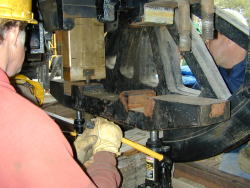
Even rain could not keep us from moving forward in the final step of the rewheeling process. Wedges and binders were jacked into place for number 1 and 3 left axles. The wedge and binder for axle 3 right are up but the binder has not been drawn up tight. Near 2PM the crew decided it was prudent to call it a day with moderate rain falling.
The image is shows wedge and binder for 3 left being jacked into place.
Modifications were completed on the extensions for the Clark and put to use. Six panels of track were relocated to allow contractors access for construction of new machine shop pad.
Even with rain it was a good day!
Re-Wheeling the 2479 - Day 4
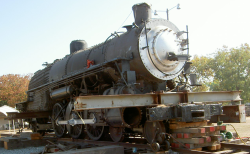
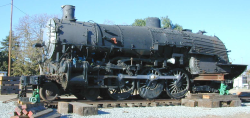
The 2479 is now on her own wheels just 2 day's shy of 15 Years from the date the wheels were removed for repair. Picture from 12:00 PM 10/28/2008
Re-Wheeling the 2479 - Day 3
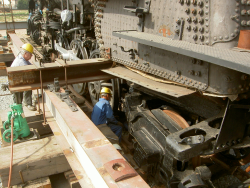
The wheels are, after so many years, once again under the locomotive. But the job is not quite done.
The day began at 8AM. First order of business was to push the backhead end of the boiler towards Tulley Road. Its amazing what can be done with a jack!
With the frame aligned to the rail we began lowering the locomotive. The difficult task was getting the trailing truck tongue into its frame slot followed by the lead truck bowl accepting the frames pedestal. These two tasks consumed the biggest part of the day. The only easy task was lowering the locomotive.
As of 4:30 PM today the journal boxes are inches away from the bottom of the spring saddle. Locomotive sure looks good with wheels near where they belong.
Tomorrow (Tuesday Oct 28) is another work day. We shall begin at 8AM.
Re-Wheeling the 2479 - Day 2
2479 is beginning to look like a locomotive again. Work continues tomorrow (Monday Oct 27) at 8AM.
The day (Sunday Oct 26) began at 8AM with a discussion about the days tasks. Removal of some locomotive piping, uncovering of the wheels and lead truck were followed by the final lift of the locomotive. A small but necessary adjustment of the rail beneath the locomotive was then completed. As a set, the three drivers were then winched forward and under the locomotive.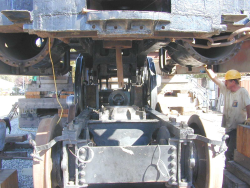
All was going rather well until the left side pin of number two driver made contact with the crib. Clearence was obtained with the help of a chain saw and the were able to continue their slow roll under the locomotive. With the drivers in place the trailing truck and lead truck were then moved by winch to their place under the locomotive.
Soon after lunch, the crew began the slow process of lowering the locomotive. Today the right front jack gave us no problems. At 4:30PM it was decided to call it quits for the day. There still remains 12 to 15 inches between the tops of the journal boxes and the bottom of the spring saddles.
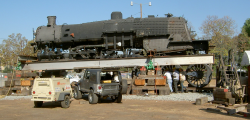
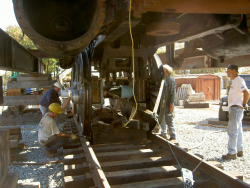
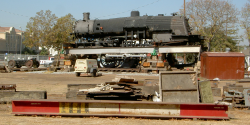
The first image above is of locomotive at its highest jack point.
Re-Wheeling the 2479, Day 1
And progress there was!

The weekday crew completed relocating the remaining "small" materials that had been located in the north east corner of the locomotive restoration site.
This morning the crew was split into two groups. One group gather tools and moved to History San Jose to push back SP1215. Those that remained at the fairgrounds continued preparations to lift 2479.
After lunch the lift began. Things progressed rather well until about 4PM when the right front corner jack began to malfunction. The jack would rise about 1 to 2 inches and stop. Several things were attempted to correct the problem without success. We turned to a 20 ton hydraulic bottle jack to assist the 35 ton air jack and continued the lift.
The only other incident occurred when we had completed jacking at the front of the loco. As crib materials were being stuffed under the front end main beam, the loco showed a very small amount of movement and it seemed to have come from the back end. Investigation revealed one of the temporary crib timbers had split, but our crib design is such that there are multiple load bearing points. If and in this case when one fails there are several other points that can bear the load.
With the locomotive at 70 inches above rail head and the time approaching 5PM, we decided to call it a day. We will start again tomorrow, Sunday, at 8AM. With some luck, the wheels should be under the loco by quitting time.
The image shows the locomotive at 5PM Saturday Oct 25.
We had a very big crew today. I don't think any one walked away with out some sore muscles.
2479 To Get Its Wheels Back
Tomorrow (Saturday Oct 25) will be the start of the 2479 re-wheeling process at the fairgrounds and the push back of SP1215 at History San Jose.
There are several tasks that must be completed on the 2479 before the physical lift can begin: install lead truck bowl, drop binders, inspect equalizer system etc.
Positioning of the wheels may take place tomorrow afternoon. Leaving the locomotive at an elevation of 75 to 80 inches off the ground for a week is not a comfortable feeling. Therefore a rare Sunday work session (and possibly Monday) is going to be necessary. It may also be necessary to work up until dusk, thus be prepared.
It's going to be a busy weekend!
2479 Update - Progress October 6 - 10
Installation of the locomotive's suspension system was completed today. Springs for number 1 driver were hoisted into place, the transverse equalizer beam was connected and the rods that connect the transverse equalizer to trailing truck equalizer levers were attached. There are a few details remaining but they cannot be completed until the suspension system is inspected upon return of Art. Progress was made in bolting the boiler's number 2 waist angle to its support. This task should be finished next week.
Completion of the above tasks puts us on schedule for rewheeling of the locomotive the week of Oct. 27. This is assuming there are no issues with the suspension system.
Work continues on the Clark forklift's exhaust system. John Z. and Bill J. managed to install a new flex pipe at the output of the exhaust manifold. Brazing is needed to complete the task.
The weekday crew continued the move to the new site. With all round house brick relocated, the crew turned to the stacks of timbers. Better then 50% of this material has been relocated. Clean up of the vacated area was also completed.
2479 Update - Sept 15-20, 2008
After several weeks of hard work, each ending in disappointment, we finally successfully bored the upper pin hole on the locomotive's front coupler. It turned out that the boring bar was not sufficiently supported. A brace was constructed and welded into position on to the bottom of the new lower pin hole plate. Boring took most of the day and is now complete. All that remains of this task is to turn out a bushing and installing that bushing into the newly bored hole. This task will not impact re-wheeling of the locomotive.
Also during the week one of two shim plates for the lead truck bowl was trimmed down on the South Bend lathe. This plate was fitted into the lead truck bowl.
Crews continue consolidation of CTRC material into the west end of the area presently occupied. Hopefully the remaining ties will be sorted and moved this coming week.
2479 Update - Sept 13, 2008
From John Ezovski
Lack of electrical power did not inhibit today's progress.
The Clark forklift was in need of maintenance. A number of items were addressed and the forklift made available for service.
Positions in the designated area for the locomotive, containers, double wide trailer and outdoor shop were identified and marked.
Machining of the lead truck bowl was completed at the trolley barn and the part returned to the fairgrounds. The only work that remains to complete the lead truck is machining of two rings that sit inside the lead truck bowl.
During this past week, the weekday crew continued to consolidate rail and ties, that were located at the east end of the big rail and tie stack, to the new area. This task continued today. Hopefully cleanup of this section will be completed by Wednesday of this coming week.
2479 Update - Sept 6, 2008
From John Ezovski
A major step forward occurred during this past week. On Tuesday Mr.Tom Johnston, Bay City Boiler, and Don Micheletti, SP2472, visited the site to view SP2479's boiler. This visit was in preparation of welding areas of 2479's boiler.
On Wednesday and Thursday, ten areas on course 2 and 3 of the boiler and firebox wrapper sheet were welded. With this work complete, various components can be installed on the locomotive's frame and re-wheeling can take place.
Re-wheeling will probably take place the last week in October. This is rather ironic as it was 15 years from this date that the wheels were removed!
The lead truck's bowl is now sitting upon the big turret lathe at the trolley barn. The ring that was welded into place last week has been turned to allow the lead truck pedestal to fit within the bowl.
Work continues on the upper coupler pin hole. Boring of this hole has been difficult. Hopefully this task will be completed this coming Saturday.
Consolidation of materials at the site continues. Ties that have been scattered about the site were collected, bundled, banded and stacked. A crew has begun to move rail located at the east end of the "pile" to an area in the new site.
2479 Boiler Welding
Today (September 3, 2008) Bay City Boiler completed the welding of the unstayed areas on the SP2479's boiler.
The thickness of each welded area was verified with the electronic thickness guage.
All that remains to this task is the filling of forms with the Federal RR Administration within 30 days.
Work Progresses
Caboose and Tender Move
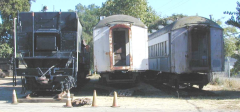
On Saturday August 30, John Zielinski led a crew (listed below) to complete the move of the caboose and tender.
The cars are now nicely positioned along side the two passenger cars. All that remains is cleanup of some material laying about the grounds. To all that participated, thank you for the help. Jockeying around 7000 pound, 39 foot long panels of track and rolling a 125,000 pound tender and 35,000 pound caboose with a forklift are no easy tasks. Hundreds of person hours work consumed by this task, and it was accomplished safely with no more then a whole lot of sore muscles!
And thanks to A-Tool shed for the loan of the compressor.
The crew:
- Art Randal
- Tom Anderson
- Phil Rule
- Ken Middlebrook
- Denis Murchison
- Larry Murchison
- John Zielinski
- John Ezovski
- Bill Jump
- Jack Young
Lead truck Bowl Ring
Art Randall prepared the bowl and ring for welding. The ring was welded into place and is now ready for transport to the trolley barn for final machining.
Front Coupler Upper Pin Hole
Art and Tom Anderson began the day by reorienting the magnetic base drill and boring bar. Boring of the upper pin hole was then restarted. There is still much work to be performed with this task.
Colorful 109 year old steam locomotive added to San Jose Railroad Museumâs growing roster.
Date: March 25, 2008
Subject: Colorful 109 year old steam locomotive added to San Jose Railroad Museum's growing roster.
From: Rod Diridon, Chairman/President
California Trolley and Railroad Corporation
Contact: Meg Fitts
Phone: 408-924-7560
Fax: 408-924-7565
http://www.ctrc.org/
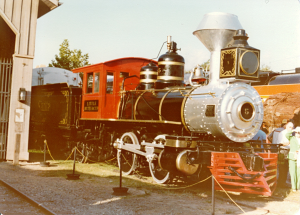
On Wednesday, April 2, a 109 year old steam locomotive will be unloaded in Kelley Park for eventual inclusion in a railroad museum proposed near downtown San Jose.
Update: There was some difficulty loading the locomotive onto the truck in Sacramento. The locomotive is now expected to arrive in San Jose on Thursday April 3rd between 10:30am and 11am.
Built in 1899 and on permanent loan to the California Trolley and Railroad Corporation (CTRC), the locomotive is nicknamed "Little Buttercup".
The locomotive originally operated in the San Francisco Bay Area. Little Buttercup had a prominent role for the Santa Fe Railroad in the 1948 Chicago Rail Fair and has been in storage since that time, most recently in Sacramento at the California State Railroad Museum. Because of its colorful appearance and small size, this engine should become a favorite for children and adults familiar with the Thomas the Tank stories.
The locomotive will be displayed within CTRC's trolley barn at the San Jose Historical Museum. This location will enable CTRC to begin a cosmetic restoration of this historic artifact. CTRC volunteers are currently restoring for operation a larger Southern Pacific steam locomotive at the Santa Clara County Fairgrounds. These locomotives and other equipment will be relocated in the future to the proposed San Jose Railroad Museum Park.
Proposed for a vacant parcel near downtown alongside the Guadalupe River Park trail, the San Jose Railroad Museum Park will feature restored railroad equipment, relocated city designated landmarks and replicated historic buildings from our community. Supplemented by educational exhibits, the facility will celebrate the railroad's roles in San Jose's agricultural and food processing heritage. With fifteen community endorsement letters already received, CTRC is actively enlisting the fiscal and political support to protect the property and eventually fund the project.
Formed in 1982 as a 501(c)(3) not for profit organization, the California Trolley and Railroad Corporation has a mission of preserving and reflecting the rich legacy of rail transportation in the Santa Clara Valley for the educational and recreational benefit of present and future generations. The organization has restored nine historic trolley cars, four of which operate for the Valley Transportation Agency's transit mall in downtown San Jose. The remaining trolleys operate for History San Jose's school aged educational programming at the historical museum in Kelley Park.
San Jose City Parks and Recreation Commission endorses museum project
By a unanimous vote the San Jose City "The Parks and Recreation Commission enthusiastically endorse the concept of a San Jose Steam Railroad Museum on the site of the 1863 San Francisco and San Jose Steam Railroadâs historical southern terminus."
Click here to see the endorsement in its entirety.
CTRC Presents Museum Plans
CTRC will be presenting the railroad museum plans to the San Jose Parks & Recreation Commission, the Santa Clara County Water District board of directors, and the San Jose City council.
We will be presenting several letters of endorsement for the project, models, and architectural renderings.
It is important that we make a strong showing; your presence at meeting will be invaluable; please plan to attend.
Times and Locations:
San Jose Parks & Recreation Commission
Wednesday February 20 (Note date and time change.)
5:30pm
Upper Watson Community Center
Annex Building
550 North 22nd Street
(Between E. Empire & Jackson Streets)
San Jose, California 95112
(Click here for map)
Santa Clara County Water District
Tuesday February 26
10:30am
SCCWD
5750 Alamaden Blvd
San Jose
San Jose City Council
Date: to be determined